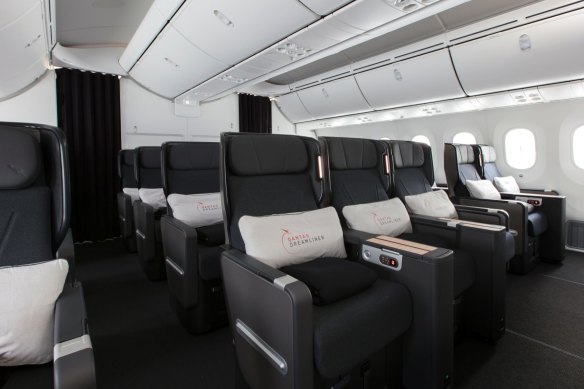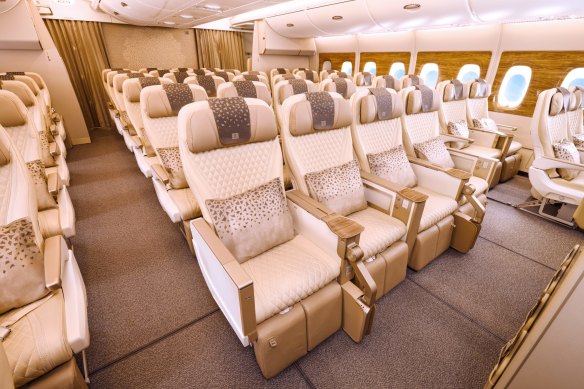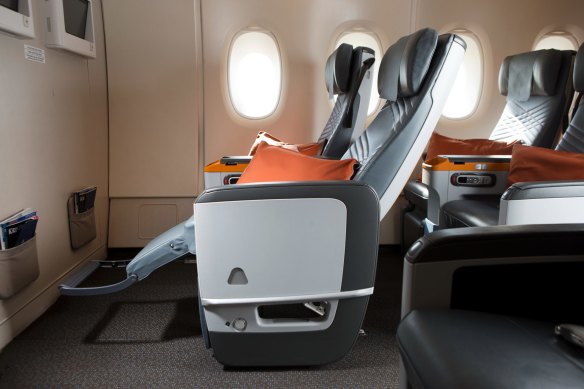Opinion
Beware – not all premium economy seats are equal
Michael Gebicki
The TripologistUnwilling to pony up for the horrendous cost of a business class seat, premium economy has become my go-to choice for flights to Europe.
A premium economy seat gives you about 15 centimetres more legroom than economy class passengers are enduring on the same flight. That’s only about the length of a large phone, but even when the passenger in front reclines your knees won’t groan.

Qantas premium economy on a Boeing 787 Dreamliner.
It’s also wider, and the recline angle is steeper than in economy. You’re in a separate cabin but you’re probably using the economy class toilet. The configuration is typically 2-4-2 or 2-3-2, and those side seats are far preferable to those in the middle.
Position is crucial. If you can’t get an aisle seat or the one behind the bulkhead, you might wonder why you’re paying 50-100 per cent more than an economy seat for marginally more legroom. That was underscored on a recent flight from Sydney to Rome flying China Eastern. On the outward journey we had the two seats on the starboard side at the front of the premium eco cabin, behind the bulkhead. Heaps of legroom, a decent seat and a newish Airbus A350, my preference over a Boeing 787.
The food and service were no different from economy class and both were frankly rubbish, but for the sake of two seats in premium economy to Europe for $5300 return you can’t be too fussy. On the return journey, premium economy was oversold on the Rome-Shanghai sector and we were upgraded to business (hallelujah!), but from Shanghai to Sydney we were squished into the central mid-section, which has four seats across. Sleeping on the overnight flight was almost impossible.
Premium economy seats to avoid (if you can)
The dreaded middle seats in mid-cabin

Premium economy on Emirates. Premium economy cabins are typically in a 2-4-2 layout.
The common configuration in the premium economy cabin aboard most wide-body aircraft is 2-4-2. That four-across middle section is the one to avoid. Get stuck with either of the two middle seats and you’re in for a lousy flight. The tray table in premium economy seats is often located in the armrest. Therefore the armrests don’t flip up. Even if you happen to find yourself with the whole four middle seats to yourself, you can’t lie down flat.
The rear of the cabin
Probably not so great. The recline angle might be limited and the economy class toilets might be close by. You’ll hear every flush, every time the door is locked. You will also be close to the economy class bassinets, which could mean screaming babies while you’re trying to sleep.
What’s the perfect premium economy seat?
The front row, side seats. Those with long legs might disagree, but for anyone under about 182 centimetres these are the pick of the seats since the bulkhead is some distance away, giving you an abundance of stretch room in front.

Singapore Airlines’ premium economy. The front row on the side is where you want to be (most of the time).
One problem, you’re in the same row as the bassinets, and that could mean trouble if you’re near a fractious infant. Also, there’s no under-seat storage, and the in-flight entertainment screen, located at the bottom of the armrest, must be stowed for takeoff and landing. Unless you’ve got a book or an e-reader you might be twiddling your thumbs until the seatbelt sign goes off and you can activate your IFE system, or retrieve material from the overhead locker.
Locating the best seat
SeatGuru was once the default choice for savvy travellers looking to bag the best seat, but it’s no longer the cutting-edge tool it once was. Now owned by TripAdvisor, the site is no longer updated, which means some of its seat maps are no longer accurate (for example, it still lists Cathay Pacific Boeing 777s as having a 3-3-3 layout in economy when most of them are now 3-4-3).
The gong now goes to SeatMaps. Key in your flight number and date of travel and you get a seat map with brilliant graphics. The site is updated frequently, the seat pitch, width and recline are all there, and for most airlines you can easily spot the dud seats. It doesn’t always come up trumps. For example, when I search for Qantas flight QF1, Sydney to London, the descriptions for first, business, premium economy and economy seats are all the same. However, the figures for seat pitch and recline are correct, and that’s all you really need to know.
Another contender is aeroLOPA, which gives you slightly more information about the seat and a read on the entertainment system and the USB and AC power connections – but unlike SeatMaps, it doesn’t spotlight the best and worst seats. It also doesn’t search by flight number. Singapore Airlines operates Airbus A350-900s in three different configurations, and aeroLOPA doesn’t tell you which one you’ll be flying.
While seat maps are a great starting point, there’s a rub. Most airlines will let you choose your seat when you make your booking. However some won’t – it’s payment first, seat selection after. In that case you’ve no idea what seats might still be available, and you might be stuck with a lemon.
correction
An earlier version of this article stated that Qantas seat selection was not available when booking until after payment is made. This was incorrect – seat selection is available before payment.
Sign up for the Traveller newsletter
The latest travel news, tips and inspiration delivered to your inbox. Sign up now.